Multifunctionality of Agriculture: The Role of Social Science in Identifying the Best Policy

Social science has been playing extremely important roles in addressing issues associated
with multifunctionality of agriculture. OECD’s work on multifunctionality was one of these
attempts, in which rigorous analytical framework based on micro economic theories contributed
to narrowing the gap between importing and exporting countries as to how these issues should
be addressed.
Agriculture is providing both commodity outputs (e.g., food and fiber) and non-commodity
outputs such as landscape, flood protection, biodiversity preservation and food security.
Multifunctionality of agriculture refers to the situation where these non-commodity outputs are
being provided to society through the production of commodity outputs.
Multifunctionality of agriculture might not be a major policy issue when the economy is
closed to the other countries. In a closed economy, demand for food needs to be met by
domestic production, and therefore non-commodity outputs could also continue to be provided
through domestic production of commodity outputs. In an open economy, however, domestic
production of food might be reduced by the increase of importing food, which in turn could
reduce the provision of non-commodity outputs.
Multifunctionality of agriculture had been one of the biggest policy issues that had divided
countries into two extreme positions; one is the position that non-commodity outputs could be
preserved only by preserving the domestic production of commodity outputs, and the other one
is that non-commodity outputs could be provided by non trade distorting measures such as those
categorized into Blue Box of the WTO agricultural agreement.
OECD’s work on multifunctionality tried to bridge the gap between these two positions, by
establishing an analytical framework based on the rigorous economic theories. Another
characteristic that features the work and is as important as being rigorous was that the analytical
framework used languages that could be shared by policy makers. This also contributed to
constructive policy discussions.
More specifically, the analytical framework defined three questions for policy makers. Only
if all of the answers to these three questions are “yes”, could the government support to
domestic production be justified, and the types of the support need to be determined by the
degree of jointness and public good characteristics of non-commodity outputs.
The first question is about jointness between commodity and non-commodity outputs,
which asks whether there is a strong degree of jointness between commodity and
non-commodity outputs that cannot be altered, for example, by changes in farming practices and technologies or by pursuing lower cost non-agricultural provision of non-commodity outputs? If
the answer is no, non-commodity outputs could be separated from commodity production, and
there would therefore be no need for supporting domestic production of commodity outputs.
If the answer to the first question is yes, the next question to be raised is whether there is
some market failure associated with the non-commodity outputs? Even if there is jointness and
decrease in domestic production of commodity outputs due to trade, economic gains obtained
through trade could exceed the loss of non-commodity outputs caused by the decrease in
commodity outputs. If this is the case, there would be no need for policy intervention to the
domestic production of commodity outputs.
If the answer to the second question is yes, agricultural trade would reduce the level of
domestic production of commodity outputs, which would lead to the net welfare loss in the
country. Then we need to ask whether non-governmental options (such as market creation or
voluntary provision) have been explored as the most efficient strategy? This is because the
justification for supporting domestic production does not guarantee that government is the most
efficient in doing so.
Finally, and only if the answer to all these questions is “yes”, then the most efficient
interventions will be defined by the nature of the jointness that exists on the supply side and by
the different public good characteristics of the non-commodity outputs on the demand side.
Various options, including central government provision, local government provision, provision
through taking advantage of consumption relationships, club provision, and community
provision should be carefully examined.
Transaction costs, including administrative costs associated with various options should also
be taken into account. The lack of information could also affect the choice of policy options.
Stability and equity concerns should also deserve careful consideration.
| Date of issued | |
|---|---|
| Creator | Mikitaro Shobayashi |
| Subject |
Analytical framework Non-commodity outputs Jointness Public good agricultural trade |
| Publisher | Japan International Research Center for Agricultural Sciences |
| Available Online | |
| Issue | 2009 |
| spage | 50 |
| epage | 56 |
| Rights | Japan International Research Center for Agricultural Sciences |
| Language | eng |
